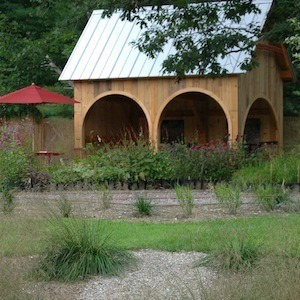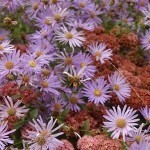About Us
We are a specialty nursery growing herbaceous ornamental wildflowers, grasses, and select hybrids and cultivars. In creating our plant selection particular attention has been given to plants which are hardy, robust-growing and low-maintenance, while embodying a more natural and wild aesthetic. It is this very same selection of plants we ourselves use to practice the art of naturalistic planting design. Meticulous plant selection is at the heart of who we are as nurseryman and designers.
 Naturalistic Planting Design
Naturalistic Planting Design
Nature is in a state of constant and dynamic change from season to season. Our focus is on herbaceous perennial plants which reflect this change while remaining beautiful, keeping our gardens attractive from spring into winter, with the last remaining seed heads persisting into the following spring. Ultimately we chose to grow a particular plant not for its rarity or popularity, but for the emotional and artistic effect it contributes to the garden as a whole. In harsher climates, such as in Maine, foliage, form and structure play a particularly important role in the garden. Since flower color is relatively short-lived, we feel plant structure to be the fundamental aspect of ornamental plants with which to design our gardens, as it is with us over a longer season. Color is best seen as an added extra (see resources: lists – “Plants with a long season of interest”).
We are keenly aware of the continual efforts of the commercial plant industry to entice the public with an ever-increasing selection of plants. In our opinion, more often than not, most newly introduced hybrids and cultivars are no better than already existing tried and true forms. We feel these efforts often lead to confuse the gardener rather than enlighten, and from these new introductions we pick and choose carefully. One exception is the renewed interest in native plants, which we believe is a very promising and beneficial trend. That said, we are active in selecting new plants for our own nursery, often as the result of growing from seed (see resources: lists – “Campo di Fiori Selections”). Too, we are plant hunters who explore different local habitats through the seasons in an effort to find indigenous plants with superior qualities. As potential new introductions to our nursery, such plants have the added benefit of helping to support a wider array of local wildlife (see plants: “Native vs. Non-native . . . Species, Hybrids, Cultivars). A visit to Popham Beach, Hermit Island, the shores of Merrymeeting Bay, as well as open, sandy, grassland-like habitats (our prairies and meadows), and open woodlands, each with their own diverse flora, provide untold inspiration.
Arte Nella Natura
 Arte nella natura, or art in nature is the underlying philosophical premise from which our perspective is formed: an aesthetic grounded in nature. Gardening is a living process which intimately and necessarily involves not only artistic vision but a basic understanding of the scientific disciplines of ecology, biology, and botany. It is this pairing of art and natural science which makes gardening wholly unique as an art form, and which leaves us in awe and appreciation through the seasons. Ultimately the greatest artist is nature itself, with its myriad beautiful organic forms and atmosphere of constant change with the play of weather and light. This we cannot attribute to science but to that latent artistic force which is expressed throughout the whole of the natural world. Complete artistic expression is not yet achieved until all that flutter and buzz find refuge in the diverse plantings we create for them. Continually we are lead to better understand the delicate balance between art and control on the one hand, and nature and wildness in the other, that which defines the true success of a garden. As both gardeners and nature lovers our goal is to inspire and encourage imagination in the art of garden creating with respect to the dynamic beauty and emotion of nature.
Arte nella natura, or art in nature is the underlying philosophical premise from which our perspective is formed: an aesthetic grounded in nature. Gardening is a living process which intimately and necessarily involves not only artistic vision but a basic understanding of the scientific disciplines of ecology, biology, and botany. It is this pairing of art and natural science which makes gardening wholly unique as an art form, and which leaves us in awe and appreciation through the seasons. Ultimately the greatest artist is nature itself, with its myriad beautiful organic forms and atmosphere of constant change with the play of weather and light. This we cannot attribute to science but to that latent artistic force which is expressed throughout the whole of the natural world. Complete artistic expression is not yet achieved until all that flutter and buzz find refuge in the diverse plantings we create for them. Continually we are lead to better understand the delicate balance between art and control on the one hand, and nature and wildness in the other, that which defines the true success of a garden. As both gardeners and nature lovers our goal is to inspire and encourage imagination in the art of garden creating with respect to the dynamic beauty and emotion of nature.
Display/Demonstration Gardens
Perennial Meadow
Traveling past the sales area and through the rustic pine-branch gate is the main display garden. Here there is a great diversity of plants with strong and long-lasting structure, used in juxtaposition, in an informal open-border, meadow-like layout. This garden is at its visual height early-summer into early winter. A small stone path runs through the deepest part of the border allowing one to immerse themselves in amongst the plants, and to experience the planting from many different angles.
Deschampsia Meadow
This garden is located in and around the lower nursery area and parking lot. It is known as a matrix planting. It is a truly contemporary way to design with ornamental plants with lots of room for experimentation. By definition a matrix is a surrounding substance within which something else originates, develops, or is contained. Often this type of planting strives to mimic a meadow or other type of open habitat dominated by grasses and forbs, such as prairie or steppe. In this case, the planting is dominated by the Deschampsia caespitosa cultivar ‘Bronzeschlier’, a cultivar of a native ornamental grass from which emerge a minority of self-seeding, spire-shaped, Digitalis ferrunginea. In the spring an abundance of Camassia leichtlinii ‘Caerulea’ makes a strong impression with its vivid blue spires of large star-shaped flowers. The intent of this garden area is to create a sense of minimalist formality, while contrasting and providing a simple backdrop to the nursery sales area. Other things demonstrated in this planting are the use of biennials/self-sowing plants for spontaneity, creating whole space through the repetition of theme plants, and the use of plants with a long-season of interest. From spring into winter this planting continues to evolve beautifully.
Carex Woodland Meadow
This garden is located in the upper nursery area and is another example of a matrix planting but with a shadier and drier aspect. Here Carex muskingumensis, an ornamental sedge native to the Great Lakes region, is the primary matrix plant. Many of the same principles of the Deschampsia meadow exist here as well, although a greater diversity of shade tolerant plants are intermixed within. Here under the shade of a giant oak, in well-draining sandy soil, we are challenged to make a shade garden for our times, one that is beautifully adapted to our increasingly dry summers. So many beautiful native woodland species from around the world are spring-flowering ephemeral plants of moist humus-rich soils, in climates with significant summer rainfall, which unfortunately here in Southern Maine, are naturally few and far between. A sitting area on the small stone patio, overlooking the fields toward the Cathance river, is situated here for your viewing pleasure.
Hybrid Hazel Demo Orchards
Two small neohybrid hazel orchards provide an example to would-be growers interested in this new type of staple food production, the newest of which can be found in its infancy, just below the Carex Meadow. Please visit the neohybrid hazel page.
Nature Walk
For those with a keen interest in naturalizing, i.e. wildflower/insect/and bird identification there exists, by permission, the possibility to explore the fields and edges of this designated conservation land beyond the nursery, while winding their way toward the Cathance river basin (see “contact” for Google maps). In mid-summer one may find the diminutive Ragged Fringed Orchis, or more likely, the field-nesting Bobolinks. From here the very adventurous may make their way onto the abandoned railway bed and walk along its course through the middle of the wetlands and riparian areas adjoining the river.

